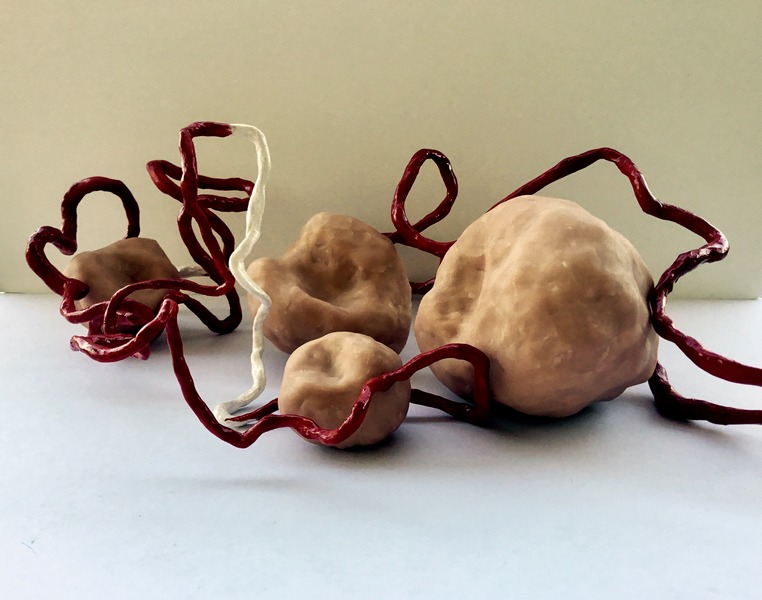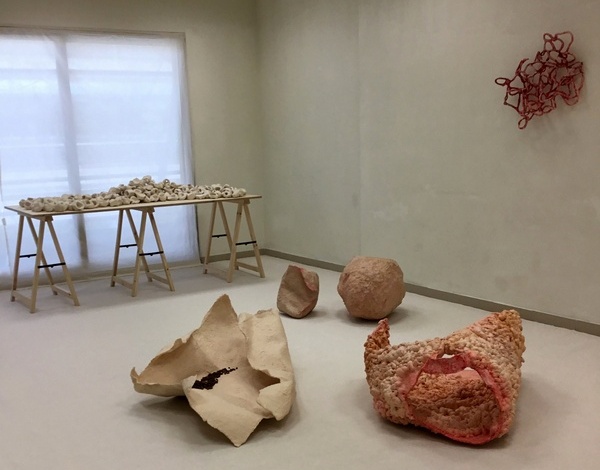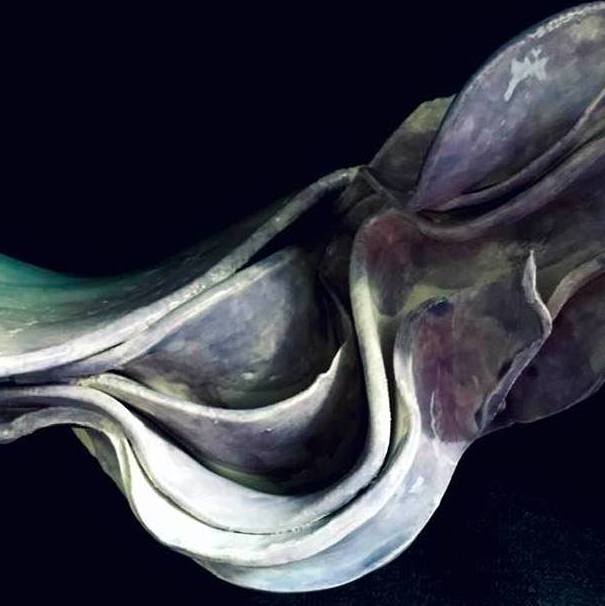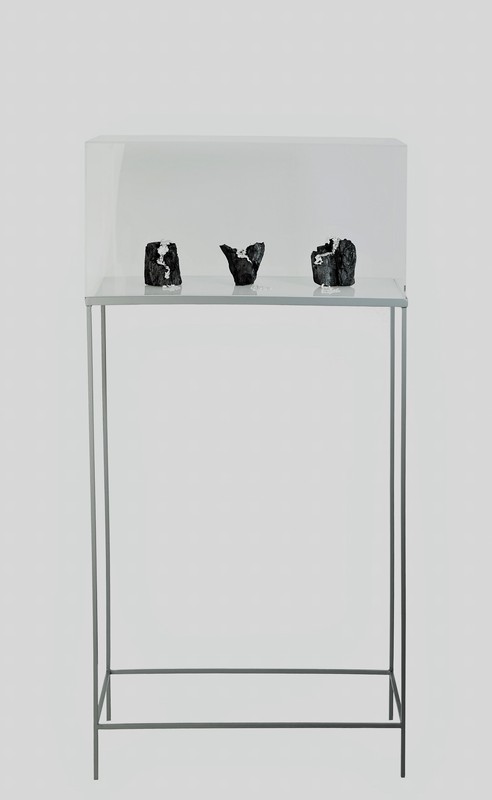Sculptural installations
Sculptures
Handmade Paper Sculptures
Ink on Paper
Paintings
Sculptural installation
ANTHRO-EXIT Are We Still Humans ?
Through this group of works I am aiming to present the "body" as symbolic and suffering, as I believe that via this way it functions as a metaphor for the current state of humanity and the fragmentation that man is experiencing within the modern society. My purpose is neither imitation nor the representation of a body as a whole, but rather to make a statement. I use the body as a medium of communication that is reflecting aspects of social realities. Through a series of sculptural installations that have an awakening nature, a revealing character, Ι deal with meanings such as oppression, humiliation and exploitation of the human being. More specifically I was intrigued to deal with the concept of "bio politics" as examined by Michel Foucault in "The Birth of Bio politics" where he explains how man and his body becomes subjected and he turns into the primary object of power.
My purpose was to visualize how power rules through fear an a politicized crowd, that is purely interested in "settling its own interests". Through this way every power is being consolidated and enforces itself, serving its own benefits. I believe that man and his body are no longer recognized as they really are in their physical state, but rather treated as "naked life", de-spiritized and de-subjected. The project raises the question of whether there is any space left for resistance against a power of such a kind and it is also a protest against the fragmentation of the human being in our times, the absolute subordination of man and the management of his biological dimension through various mechanisms. I believe that the human body has nowadays become the primary object of power and a primary place for the function and legalization of the power's contemporary forms. Similar questions are raised by several thinkers of the 20th century, such as Noam Chomsky, Gilles Deleuze and Giorgio Agamben, which will be analyzed further below.
The subjugation of the human body, its arbitrary and unimpeded tradition in the modern function of power, are the issues I want to address. The work is a depiction of today's reality, and at the same time it implies resistance against the fragmentation of the human being in our time. We are currently living in an era where virtual reality prevails and our environment is turning more and more virtual and fake without the corresponding real content as a counterpart. This is what motivated me so as to convey my concerns and worries, by constructing a symbolic, however real environment; a sculptural installation that will activate the viewer and make him think. This environment is a three-dimensional space, where one can wander among strange forms that may resemble fragmented, submissive bodies that are obedient and disciplined. It is a place that may leave an aftertaste of some "invisible", sophisticated, elaborated, yet effective and productive power.
Sculpture
STRUGGLE FOR FREEDOM
A synthesis of small-sized sculptures where one can view amorphous masses that resemble people; people who are fighting in a struggle to gain freedom and life thus conquering it. However these people do encounter some form of resistance, some opposition, possibly due to the fact that a "free" man is a dangerous man, as he holds the potential of overturning someone else's plans. This is the central idea upon which my work is based on; mankind's battles in an attempt to achieve its right to live in freedom.

polymeric clay, acrylics, wire, paper
45 x 45 x 15 cm
Sculpture
ICARUS
Greek myths are not just imaginary stories. They are of complex cultural character and interpretation. They are parallels of the human existence that link all areas of it, such as society, philosophy, literature and art. They are, even today, a source of inspiration for people of the arts. To me, they are a trigger for creation. Stripping the casing, the outer shell of a myth, I find myself proceeding into a deeper approach and analysis, attempting a philosophical interpretation of it. I have always wondered about who Icarus really was, or is. I came to the conclusion that, in a sense, we are all modern Icari, who during our lifespan are trying to spread our wings and fly to chase the light, the truth. My theory is that history describes the evolution and development of each one of us. It is not the supposed decline of Icarus that corcerns me, simply because from my perspective the essence is in the flight, the rise of man towards the truth. The Icarus sculptures depict the trail left behind in the ether by the wings, the recording of the movement, the imprint of the intangible passage of an Icarus seeking the light.
Sculpture
FROM DARKNESS TO LIGHT
The placement of the artwork within the showcase is of particular importance. In general, showcases are used as a means of revealing our desire for exhibiting and preserving valuables while creating an ambiguous attitude towards the viewer, who feels being both attracted and repelled at the same time. The ambiguous effect of the showcase, calling to the viewer but simultaneously blocking him, creates tension. The combination of coal with pure silver, two materials so opposite and alien to each other, portrays the evolution of human existence and symbolizes progress and cultural evolution.

charcoal, silver, plexiglass, metal, light 145 x 70 x 35 cm
Handmade Paper Sculptures
REASON & IMAGINATION
Handmade paper, natural fibers, seeds, ink. Exploring the architecture of these organic and traditional elements, utilizing them as a medium and converts them into an art-piece. It is almost as if listening to Goya saying: "Reason united with imagination produces art".
Ink On Paper
PAINFUL YET REDEEMING
It is in man's nature to be guided and focused on a constant search. Man seeks companionship, prosperity, joy and knowledge. However the fundamental search for the truth begins from within. The journey within oneself in often painful yet redeeming at the same time. It is an archetypal question, ancient and yet so topical.
Paintings
AETHER
Aristotle added a fifth element, aether (αἰθήρ ai-aether) and defined it as the quintessence. He argued that whereas fire, earth, air, and water were perishable earthly elements, since no changes have been perceived in the heavenly regions, the stars cannot be made out of any of the four elements, but must consist of an alternate, unchangeable, heavenly substance; Aristotle called this the fifth element. Maybe, while creating these paintings the artist gets imaginatively transported to the aether and attempts to capture a glimpse of that substance.



